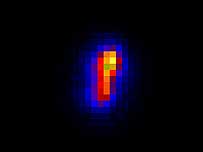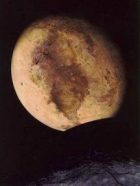Sizing up Pluto’s moon
Pluto's rocky moon Charon appears to lack an atmosphere.
By Emily Sohn
Pluto’s moon Charon recently took a trip on the dark side. On July 10, 2005, the moon passed in front of a star, briefly blocking the star’s light. This brief blockage, however, was long enough to give astronomers new information about Pluto’s rocky partner.
 |
|
This image from a movie shows an early stage in the passage of Pluto’s moon Charon in front of a star (smaller yellow dot).
|
| Image courtesy of MIT Planetary Astronomy Laboratory |
Passing in front of a star is a rare event for Charon. The trip lasted less than a minute, and it was visible only from a 980-kilometer (609-mile) stretch of land in South America. The passage of one celestial body in front of another is known as an occultation.
Two teams of astronomers watched the event through telescopes in Chile and Brazil. One team works at the Massachusetts Institute of Technology and Williams College. The other is from the Paris Observatory.
The observations show that Charon has a radius of 606 kilometers (377 miles). In other words, it measures about 754 miles across. This new size estimate, combined with data obtained by the Hubble Space Telescope, indicates that the moon is 1.71 times as dense as water. Earth’s density is about three times that of Charon, suggesting that, unlike Earth, Charon is largely made up of rock and ice.
 |
|
This painting gives an artist’s impression of what Charon might look like as seen from Pluto.
|
| NASA |
The scientists couldn’t tell for sure whether Charon has an atmosphere. If there is one, however, it’s less than one-millionth as dense as Earth’s atmosphere is.
The new data support the theory that Charon formed when a big object collided with Pluto and flung off a chunk. Earth’s moon probably formed in the same way.—E. Sohn
Going Deeper:
Cowen, Ron. 2006. Stellar passage yields Charon’s girth. Science News 169(Feb. 18):110. Available at http://www.sciencenews.org/articles/20060218/note15.asp .
You can learn more about new studies of Pluto’s moon Charon at web.mit.edu/newsoffice/2006/charon.html and web.mit.edu/newsoffice/2005/charon.html (Massachusetts Institute of Technology). Additional information is available at www.williams.edu/admin/news/releases.php?id=1106 and www.williams.edu/admin/news/releases.php?id=1002 (Williams College).
You can see a movie of the event at occult.mit.edu/research/occultations/Charon/C313.2/C313OccMovie.html (Massachusetts Institute of Technology).
Sohn, Emily. 2005. Pluto’s new moons. Science News for Kids (Nov. 9). Available at http://www.sciencenewsforkids.org/articles/20051109/Note2.asp .
______. 2005. Solving a Sedna mystery. Science News for Kids (May 4). Available at http://www.sciencenewsforkids.org/articles/20050504/Note3.asp .
______. 2004. Planets on the edge. Science News for Kids (April 7). Available at http://www.sciencenewsforkids.org/articles/20040407/Feature1.asp .







